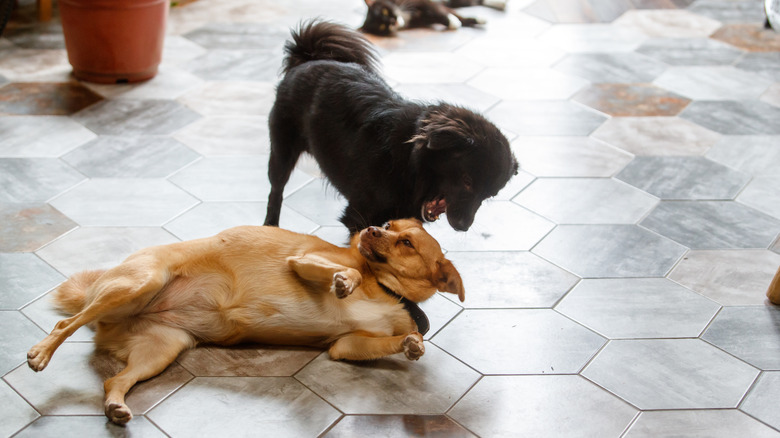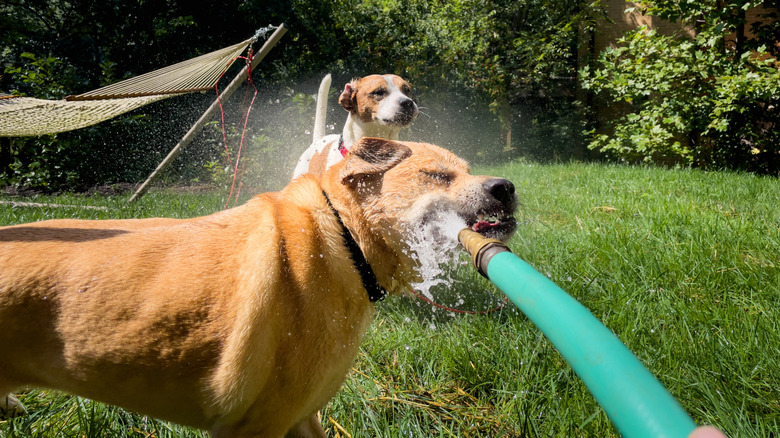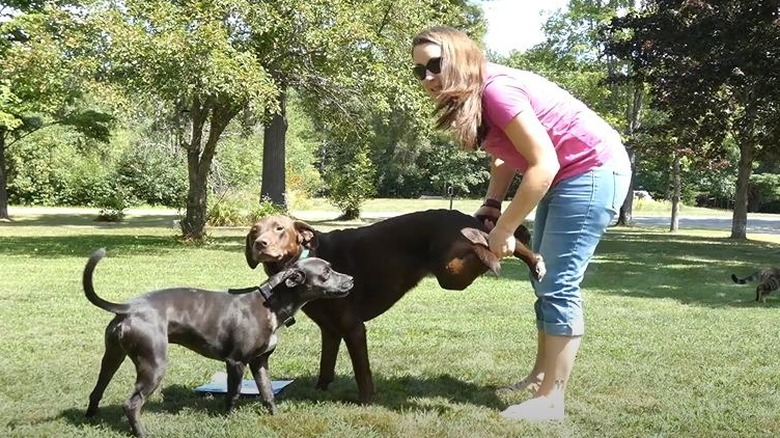How To Safely Break Up A Dog Fight In Your Home Or Yard
Having two dogs at home is like having two young children; at some point, they're probably going to fight. However, one big difference between a human spat and a dog brawl is that breaking up the latter can be extra dangerous, especially if a larger dog is involved (here's the real difference between medium and large dogs). After all, many dog owners have been bitten or even ended up in the emergency room after attempting to intervene in a fight. While reflexively pulling your angry canines apart may be the first thing that comes to mind, there are other safer, more strategic ways to end a dog fight in your home — namely, by distracting them or using an object to physically separate them.
Squabbles are more likely to occur when a new pupper is added to a home, as the resident dog may feel threatened and lash out at its new family member. However, even dogs that typically get along might fight over a new chew toy or after getting an accidental injury during play. So, although you may think you'll never encounter a dog fight in your home, it's always good to be prepared anyway because you simply never know. It's also helpful to learn the difference between playful and aggressive growling so you can prevent dog fights from happening in the first place.
Create a distraction to stop your dogs from fighting
Regardless of what triggered the squabble, chances are high that your dogs don't want to be in that predicament and would be grateful for a distraction. You can create one with noise or an object. The fastest and easiest method is to shout and clap your hands. If you've yelled at your dogs before for bad behavior, they may stop fighting on their own after hearing your shouting. Another option is to clang a pair of pots or garden tools together or turn the vacuum on beside them, as many dogs (and cats) are scared of vacuum cleaners.
For a physical distraction, you can throw a blanket or large pillow on them — or any other safe object that you know will startle them. For an outdoor fight, you can use your patio furniture cushions. A blanket can disorient them and cause them to recede from each other. A pillow might divert their attention elsewhere for a few seconds, long enough for you to get between them. Many dogs fear large objects, so placing an empty cardboard box on top of them is another intervention option (as long as it's larger than they are, of course).
Water can also be a safe physical interference. Either spray them with a spray bottle (the kind you use for your hair, for example) or pour some water in a bowl and pour it over them. If the tussle is in your yard, you can use your hose, but only if the water is at a safe temperature; hose water has the potential to become dangerously hot in the summer.
Physically separate your dogs with an object
If creating an audible or physical distraction doesn't work, try placing an object like a broom or a mop between your fighting dogs. A large, flat surface, such as a foam board, flattened cardboard box, or storage bin lid can also work if you have one nearby. Just make sure the object is large enough or long enough to place between them while allowing your hands to remain a safe distance from their mouths.
Brooms and mops provide the advantage of long handles and large, soft heads. A rake with a plastic head can also work for outdoor melee. Hold onto the handle, and place the head between your dogs, moving it from side to side if necessary. With a board or storage bin lid, you can try to push it between them and obstruct their vision from each other. Keep in mind that your dogs might bite the interfering object in response, so stay alert.
If an adult is with you and is willing and able to assist, you can use the wheelbarrow method as a last resort. With this technique, your hands serve as the means of physical separation. Have the other person gently pull back on one dog's hind legs while you pull the other dog's hind legs. While holding onto the legs, turn your body to prevent being bitten and to prevent them from returning to the dog.


